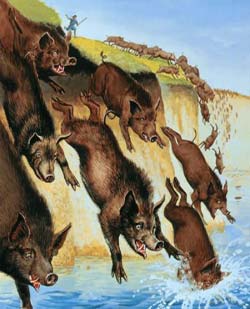This question was asked by Greta van der Rol, an Australian writer of historical fiction (“To Die a Dry Death”) and science fiction (the “Iron Admiral” books).
When the Romans had permanent bases, they used their soldiers as builders: roads, farms, towns, aqueducts.
“When on station, the soldiers (…) always maintained a herd of cattle, sometimes herding other animals such as sheep and goats, grew grain and other crops, including vegetables, and foraged for variety.” (http://romanmilitary.net/people/food)
A Legion of 8,000 men engaged in hard labor ate a lot.
“It is estimated that just the soldiers in Britain ate over 33.5 tons of grain a day.”
Plus they liked pork and bacon!
“A soldier always marched with at least a good supply of bacon, hard tack biscuits, and sour wine.”
For hundreds of years the Romans had a Legion (or more) stationed in Palestine. They were there permanently, not on some hit-and-run Panda operation (“eats shoots and leaves”). Undoubtedly they had their own farms – and Romans did things on a very large and impressive scale. Shipping that much food around would have been foolishly expensive and inefficient, even if you had as good a port as Sebaste, built by Herod the Great at Caesarea Maritima.
And the food would still have to been farmed somewhere.
That said, the story of the Gadarene Swine in the three Synoptic Gospels was written down a generation after Jesus’ execution, by people who had heard it from other people who in turn remembered it a little differently, with added elements of bravado (from the Zealots) and exaggeration (from the fishermen) and deliberate obfuscation (from the pro-Roman Paul).
Pigs would be a prime target for Zealots, as pigs should not have been farmed and eaten in Israel. And it would have been almost impossible not to give the Romans the nickname “pigs” – big ugly grunting unclean creatures, pig-eating and marching around under their Legion’s boar standard.
And, accurate or not, the number of 2,000 may have been a deliberate echo of the number of Jews crucified four miles from Nazareth during Jesus’ childhood, when “the Roman pigs” suppressed the uprising by Judas of Galilee.


